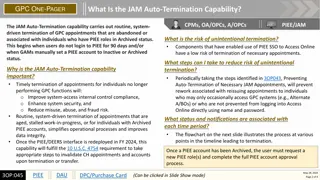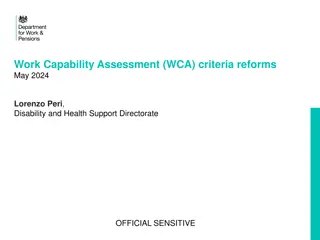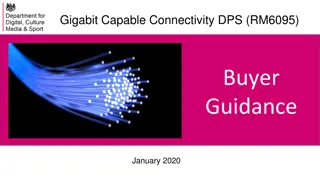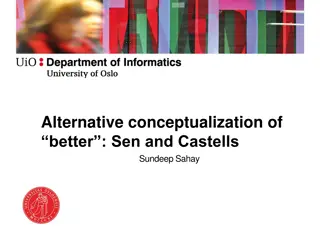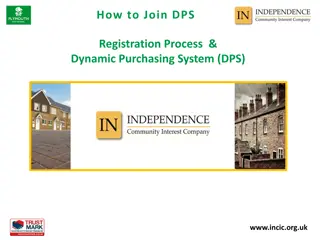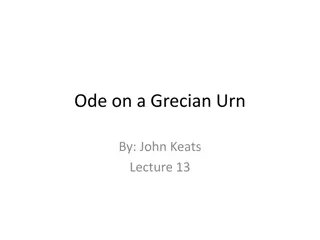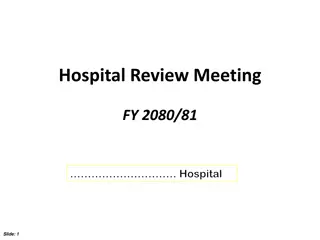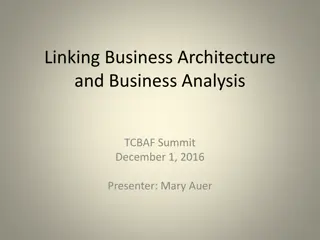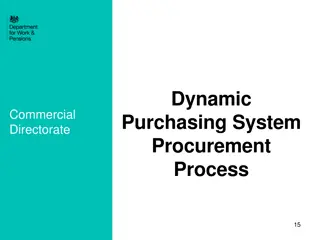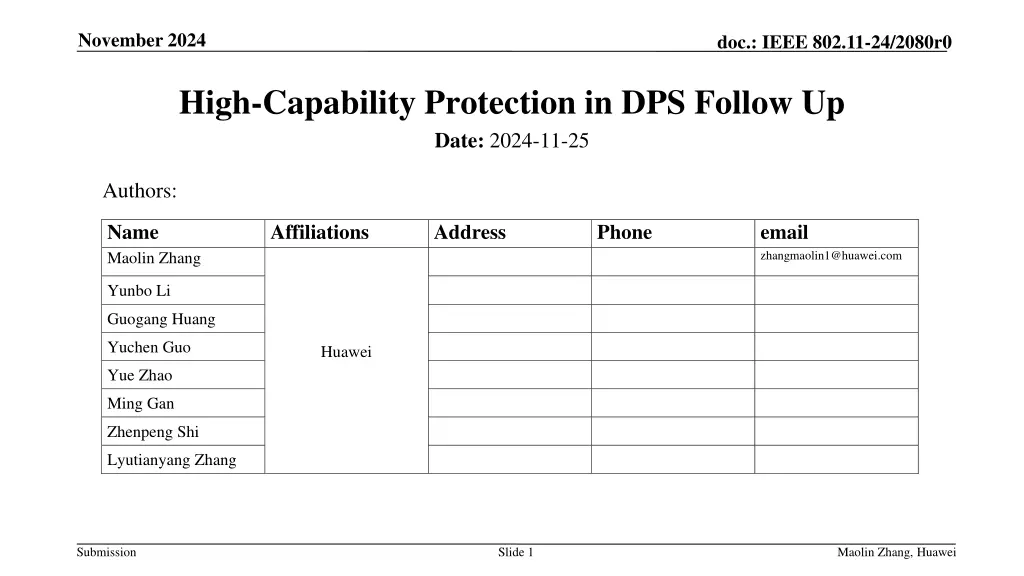
IEEE 802.11-24/2080r0 High-Capability Protection in DPS Proposal
Explore the proposal for high-capability protection in Dynamic Power Save (DPS) mode under IEEE 802.11-24/2080r0, discussing the motivation, introduction, and detailed steps for implementing high-capability protection time in DPS scenarios. The proposal aims to optimize data transmission efficiency, reduce unnecessary padding costs, and enhance overall performance in wireless communication standards.
Download Presentation

Please find below an Image/Link to download the presentation.
The content on the website is provided AS IS for your information and personal use only. It may not be sold, licensed, or shared on other websites without obtaining consent from the author. If you encounter any issues during the download, it is possible that the publisher has removed the file from their server.
You are allowed to download the files provided on this website for personal or commercial use, subject to the condition that they are used lawfully. All files are the property of their respective owners.
The content on the website is provided AS IS for your information and personal use only. It may not be sold, licensed, or shared on other websites without obtaining consent from the author.
E N D
Presentation Transcript
November 2024 doc.: IEEE 802.11-24/2080r0 High-Capability Protection in DPS Follow Up Date: 2024-11-25 Authors: Name Maolin Zhang Affiliations Address Phone email zhangmaolin1@huawei.com Yunbo Li Guogang Huang Yuchen Guo Huawei Yue Zhao Ming Gan Zhenpeng Shi Lyutianyang Zhang Submission Slide 1 Maolin Zhang, Huawei
November 2024 doc.: IEEE 802.11-24/2080r0 Introduction Low power listen mode was proposed by [1]. References[2-6] continue to develop the low power listen mode to dynamic power save (DPS) and provide more details. References[4, 5, 7] propose to add a new Intermediate FCS field before the padding so that the STA can use the padding time to change bandwidth. STA in DPS mode will start switch from the high-capability mode to the low-capability mode before the end of the TXOP if DPS uses the same switch-back rules as EMLSR. When capability switching involves bandwidth changing, the round-trip switch delay is relatively large [9]. Submission Slide 2 Maolin Zhang, Huawei
November 2024 doc.: IEEE 802.11-24/2080r0 Motivation The round-trip switch delay (e.g. 512 s ) accounts for a high proportion of the time-limited TXOP. If the data transmission has not been completed and capability switches are performed each TXOP, there will be a large unnecessary padding cost and time waste. For some data transmission tasks, the transmission duration can be roughly estimated in advance based on the amount of data and PHY capabilities. Switch back delay Low-capability mode High-capability mode Low-capability mode ICF padding Duration Switch delay If it is determined in advance that the data transmission task cannot be completed within one TXOP, it is not appropriate to force the DPS STA to return to the low-capability mode at the end of the TXOP and reawaken it in the next TXOP (e.g. a total of 512 s is wasted). Submission Slide 3 Slide 3 Maolin Zhang, Huawei
November 2024 doc.: IEEE 802.11-24/2080r0 Proposal 1: High-capabilityprotection time Taking STA DPS as an example. ICF from AP can indicate time or duration information based on data volume and capabilities in high-capability mode. STA replies ICR, which also contains time information based on ICF. STA starts switching back on or after the indicated end time. If the time span exceeds the TXOP, AP does not need to switch the STA to high-capability mode on next TXOP, it can directly communicate with the STA in high-capability. Switch back delay Low-capability mode High-capability mode Low-capability mode ICF padding TXOP TXOP TXOP Duration Switch delay If AP need to increase or decrease the time, it can send ICF w/o padding but w/ time information to update the end time. STA replies ICR containing the updated time information. Submission Slide 4 Maolin Zhang, Huawei
November 2024 doc.: IEEE 802.11-24/2080r0 Proposal 1: High-capabilityprotection time Time information in ICF and ICR can be used to protect high capability. First, the time can be initially estimated; Second, the time can be updated based on the actual transmission progress. High-capability protection time can be used for both TXOP level DPS and cross-TXOP DPS. High-capability protection time can be used as a mode that can be turned on or off. This mode can be enabled in scenarios where data transmission is expected to be completed as soon as possible. Switch back delay Low-capability mode High-capability mode Low-capability mode ICF padding Duration Switch delay Submission Slide 5 Maolin Zhang, Huawei
November 2024 doc.: IEEE 802.11-24/2080r0 Proposal 2: Flexible time threshold If the time without successful frame exchange between AP and DPS STA exceeds a time threshold, the DPS STA starts switching back. (The time threshold can be indicated during DPS operation parameters update phase. It can be larger than EMLSR s timeout interval because DPS does not need to switch as sensitively as EMLSR. The larger time threshold offers robustness for DPS. Robustness is another way to protect high-capability.) Time threshold AP Data ACK DPS STA High-capability mode Low-capability mode Switch back delay STA starts switching back In EMLSR, the timeout interval (aSIFSTime + aSlotTime + aRxPHYStartDelay) is the time that a receiver can use to determine whether the received packet is intended for itself or not. If a frame that requires immediate acknowledgement has an error when received by STA, the STA will directly switch back. DPS and EMLSR have different purposes and characteristics. The purpose of EMLSR is to find a frequency band with better channel quality, so once it finds a problem with the current band, it will switch to another. However, the problem may not be a problem for DPS. For example, AP can wake up multiple DPS STAs at the same time, with a larger time threshold, some STAs are allowed to wait for a period of time instead of switching back immediately once it finds that the current frame is not for themselves. Submission Slide 6 Maolin Zhang, Huawei
November 2024 doc.: IEEE 802.11-24/2080r0 Proposal 2: Flexible time threshold If the time without successful frame exchange between AP and DPS STA exceeds a time threshold, the DPS STA starts switching back. (The time threshold can be indicated during DPS operation parameters update phase. It can be larger than EMLSR s timeout interval because DPS does not need to switch as sensitively as EMLSR. The larger time threshold offers robustness for DPS. Robustness is another way to protect high-capability.) Time threshold AP Data DPS STA ACK High-capability mode Low-capability mode Switch back delay STA starts switching back In addition, it takes more time to change the bandwidth in DPS. When data transmissionhas not been completed, oversensitive switchback mechanism may reduce goodput and counteract power saving. Being more robust can avoid the time, padding and power overhead of unnecessaryfrequent switching. Time threshold TXOP Time threshold TXOP AP DPS STA Switch back delay Low-capability mode High-capability mode STA starts switching back In another case, when AP does not complete data transmission within the current TXOP and the AP regains a new TXOP within the time threshold, it can directly send packets to the DPS STA in high-capability mode without spending time to wait the DPS STA go back to low-capability mode and wake it up again. Submission Slide 7 Maolin Zhang, Huawei
November 2024 doc.: IEEE 802.11-24/2080r0 Proposal 2: Flexible time threshold Use case 1: When an error occurs in data reception, the AP is allowed to retransmit the frame before the DPS STA switches back to low-capability mode with a larger time threshold. Use case 2: When the data is not completely transmitted, and the original TXOP initiator regains a new TXOP within the time threshold, the DPS STA can maintain high-capability mode across TXOPs. Use case 3: If the original TXOP initiator does not regain a new TXOP within the time threshold, the DPS STA will start switch back at the end of the countdown. Use case 4: AP wakes up multiple DPS STAs at the same time, AP can prioritize some STAs or temporarily schedule other STAs. Submission Slide 8 Maolin Zhang, Huawei
November 2024 doc.: IEEE 802.11-24/2080r0 Summary In this contribution, we propose high-capability protection methods in DPS to avoid frequent capability states switching and unnecessary time, padding, and power overhead before data transmission is completed. Due to the introduction of high-capability protection, it is possible to achieve DPS across TXOPs in the case where the data transmission is not completed within one TXOP. The switchback conditions can be used for both TXOP level DPS and cross-TXOP DPS in the case where DPS is enabled, but EMLSR is disabled. Switch-back conditions with high-capability protection can cope with various practical scenarios in DPS. Submission Slide 9 Maolin Zhang, Huawei
November 2024 doc.: IEEE 802.11-24/2080r0 References [1] 11-22-1414-00-0uhr-low-power-listening-mode [2] 11-23-0010-00-0uhr-considerations-for-enabling-ap-power-save [3] 11-23-1875-01-00bn-power-save-proposal-for-non-ap-mobile-ap [4] 11-23-2003-00-00bn-client-power-save [5] 11-23-1965-00-00bn-dynamic-power-save-follow-up [6] 11-24-0485-00-00bn-low-power-listening-mode-for-clients [7] 11-23-1873-00-00bn-post-fcs-mac-padding [8] 11-23-1942-00-00bn-inter-ppdu-low-power-listening-scheme [9] 11-24-0844-00-00bn-padding-time-in-dynamic-power-save Submission Slide 10 Maolin Zhang, Huawei
November 2024 doc.: IEEE 802.11-24/2080r0 SP 1 Do you support to include the following in the 11bn SFD? If the time without successful frame exchange between AP and DPS STA exceeds a time threshold, the DPS STA starts switching back. The time threshold for switch-back can be indicated in the DPS operation parameters update phase. Submission Slide 11 Maolin Zhang, Huawei
November 2024 doc.: IEEE 802.11-24/2080r0 SP 2 Do you support to include the following in the 11bn SFD? The high-capability duration in DPS can be exchanged and updated through ICF and ICR. Submission Slide 12 Maolin Zhang, Huawei
November 2024 doc.: IEEE 802.11-24/2080r0 SP 3 Do you support to include the following in the 11bn SFD? When data transmission for DPS STA is not completed, the DPS STA are allowed to maintain the high-capability mode across TXOPs. Submission Slide 13 Maolin Zhang, Huawei

